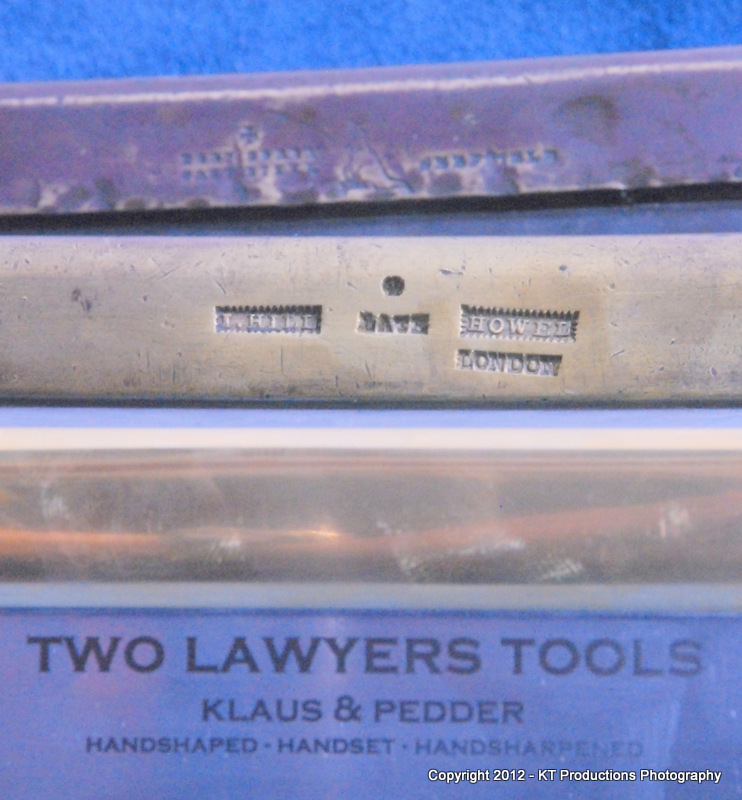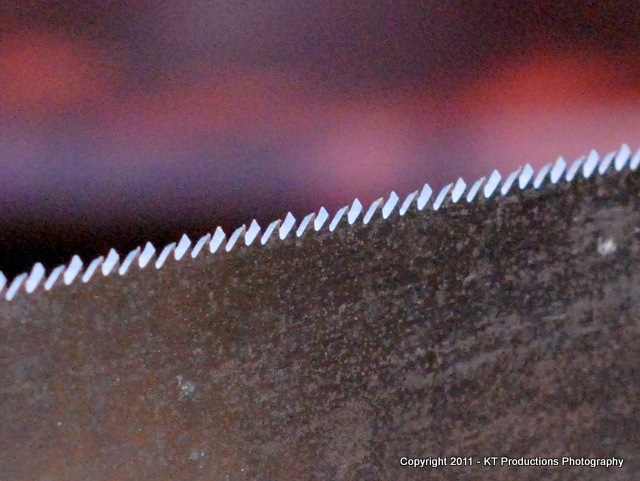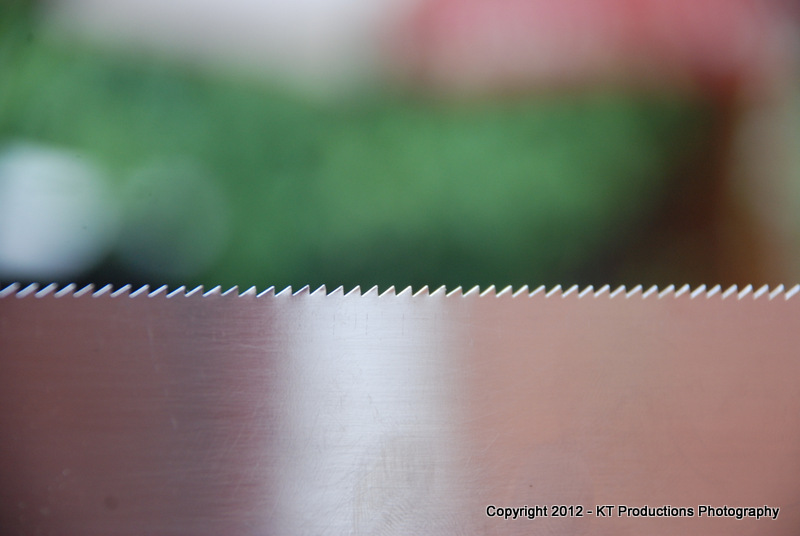You are using an out of date browser. It may not display this or other websites correctly.
You should upgrade or use an alternative browser.
You should upgrade or use an alternative browser.
Hand Saws - questions questions
- Thread starter Togalosh
- Start date

Help Support UKworkshop.co.uk:
This site may earn a commission from merchant affiliate
links, including eBay, Amazon, and others.
No skills
Established Member
Thanks to Pedder and CC for the fast infomation  ccasion5:
ccasion5:
Cheshirechappie
Established Member
No skills - if you're going to practice, can I suggest you start with the big rip saw? You have nice big teeth, so it's easy to see what you're doing, and you only have one angle to worry about - rake. Both fleam and slope are zero for a rip saw.
1) Joint the saw so that all the teeth are the same height.
2) Reshape any teeth that have lost height in the jointing, shaping them to give about 5 degrees of rake. File slowly and deliberately - harder steels like sawblades respond best to a slow filespeed.
3) Set to give a kerf about 1 1/2 times the blade thickness - no more. Just set the tips of the teeth, don't try to bend near the root.
4) Make a final gentle pass with the sawfile to sharpen all the tips.
5) Test - with luck, the wood will give up the struggle as soon as it sees the saw approach!
Then try with a rip-cut backsaw. Crosscuts can wait until you're confident with filing technique.
1) Joint the saw so that all the teeth are the same height.
2) Reshape any teeth that have lost height in the jointing, shaping them to give about 5 degrees of rake. File slowly and deliberately - harder steels like sawblades respond best to a slow filespeed.
3) Set to give a kerf about 1 1/2 times the blade thickness - no more. Just set the tips of the teeth, don't try to bend near the root.
4) Make a final gentle pass with the sawfile to sharpen all the tips.
5) Test - with luck, the wood will give up the struggle as soon as it sees the saw approach!
Then try with a rip-cut backsaw. Crosscuts can wait until you're confident with filing technique.
No skills
Established Member
Hi CC, my first victim will be one of the basket case 26" dissons I got - hopefully the teeth will be big enough for me not to cock it up too bad  - I've got a 28" disson rip saw coming as well so plenty to play with once I get my files and set. I will probably have to get some reading material before I get stuck in as well, I do get lost with what should be crosscut/rip which angles etc etc
- I've got a 28" disson rip saw coming as well so plenty to play with once I get my files and set. I will probably have to get some reading material before I get stuck in as well, I do get lost with what should be crosscut/rip which angles etc etc
Cheers!

Cheers!
bugbear
Established Member
pedder":15fkz8f0 said:To sharpen a saw, that just became a little dull (think of any modern saw after 1 years of hobby use) is very easy. All you need is one stroke per gullet. Better to exercise this at a cheap saw, though.
It is a complete different animal to file old saws that have had a few sharpenings and are often badly filed. This resharpening (reshaping the teeth indeed) takes a few saws to learn.
That fits very well with what I experienced.
I think in some cases, I'd have found it quicker and easier to strip the (awful) old teeth off completely, and file fresh teeth as opposed to working to improve the existing teeth.
I diagrammed some of the "interesting" issues on my must-get-i-rehosted site:
http://web.archive.org/web/200910271345 ... ml#reshape
BugBear
Togalosh
Established Member
Blimey, what a great response ! Thanks gents for your generous sharing of knowledge, I'm very apprecaitive of your help.
..there's so much for me to take in & look into now - it should keep my questioning at bay for a while (well I've 1 more thread for now).
The only querstion I was not clear in asking was "how long does a blade last? "..I should've asked "how often do you sharpen your blades?" (assuming you are not a obsessive sharpener). I read that it should be a little & often, which is the same for all edge tools & knives..but I was just curious to know an average - if there is one.
..there's so much for me to take in & look into now - it should keep my questioning at bay for a while (well I've 1 more thread for now).
The only querstion I was not clear in asking was "how long does a blade last? "..I should've asked "how often do you sharpen your blades?" (assuming you are not a obsessive sharpener). I read that it should be a little & often, which is the same for all edge tools & knives..but I was just curious to know an average - if there is one.
Cheshirechappie
Established Member
Keep asking the questions! They've resulted in a some really interesting discussion. I've been reading woodwork books and magazines, and butchering bits of wood (in a very amateurish fashion), for the best part of thirty years, and I've still learned allsorts from questions like these.
How often to sharpen a saw? Ah - well - that's a bit of a 'how long is a piece of string' question. Aside from the trite (and rather unhelpful) 'as often as it needs it', there are so many variables that there isn't a sensible average time interval. In the book, 'The Tool Chest of Benjamin Seaton', there is a passage suggesting that saws needed sharpening twice a week - but these were being used by craftsmen working an 80-hour week, and having no access to machinery - their saws got a LOT of use. At the other end of the scale, I suspect that most of us amateurs have saws that have done some years between sharpenings - especially the ones that don't get much regular use.
One indicator that might help is to turn a saw teeth up, and very lightly pass a finger end or the ball of a thumb along the tips of the teeth. If they snag the skin lightly, or catch, the teeth are sharp. If the skin slides easily over the tooth tips, the saw would benefit from a touch-up with a file. Take a look at the tips, too. A gleam of light on each toothtip indicates a polish that suggests the edge has been worn off - no gleam of light indicates no surface on the tip to reflect light, and therefore a sharp tip.
How often to sharpen a saw? Ah - well - that's a bit of a 'how long is a piece of string' question. Aside from the trite (and rather unhelpful) 'as often as it needs it', there are so many variables that there isn't a sensible average time interval. In the book, 'The Tool Chest of Benjamin Seaton', there is a passage suggesting that saws needed sharpening twice a week - but these were being used by craftsmen working an 80-hour week, and having no access to machinery - their saws got a LOT of use. At the other end of the scale, I suspect that most of us amateurs have saws that have done some years between sharpenings - especially the ones that don't get much regular use.
One indicator that might help is to turn a saw teeth up, and very lightly pass a finger end or the ball of a thumb along the tips of the teeth. If they snag the skin lightly, or catch, the teeth are sharp. If the skin slides easily over the tooth tips, the saw would benefit from a touch-up with a file. Take a look at the tips, too. A gleam of light on each toothtip indicates a polish that suggests the edge has been worn off - no gleam of light indicates no surface on the tip to reflect light, and therefore a sharp tip.
jimi43
Established Member
Indeed there has been a vast amount of knowledge condensed or summarized in this thread...a most useful one indeed.
I think that sharpening should also be qualified again here...
First we have a new saw that gets blunt in use and a very fine hone can probably be done by most keen amateurs just to keep it in trim...as advised by Pedder.
After a certain point in time...the saw will need resharpening...if not done correctly it will need various degrees of recovery by a saw doctor to the point of totally recutting the teeth, sharpening and resetting.
My three backsaws have undergone all these extremes...

The Robert Sorby (mid 19thC) was re-worked completely using the original steel....

The Hill LATE Howel...sadly succumbed to over 180 years of metal fatigue and has a new steel...

...and Ginger is just starting her long life in the certain knowledge that she will be around in 150 years time for a touch up! :wink:
One thing is for sure...I have no intention of even pretending to know enough about saws to do anything other than lightly touch these babies...I'll leave that to Pedder...his son...and his son's son!! :mrgreen:
Jimi
I think that sharpening should also be qualified again here...
First we have a new saw that gets blunt in use and a very fine hone can probably be done by most keen amateurs just to keep it in trim...as advised by Pedder.
After a certain point in time...the saw will need resharpening...if not done correctly it will need various degrees of recovery by a saw doctor to the point of totally recutting the teeth, sharpening and resetting.
My three backsaws have undergone all these extremes...

The Robert Sorby (mid 19thC) was re-worked completely using the original steel....

The Hill LATE Howel...sadly succumbed to over 180 years of metal fatigue and has a new steel...

...and Ginger is just starting her long life in the certain knowledge that she will be around in 150 years time for a touch up! :wink:
One thing is for sure...I have no intention of even pretending to know enough about saws to do anything other than lightly touch these babies...I'll leave that to Pedder...his son...and his son's son!! :mrgreen:
Jimi
bugbear
Established Member
Cheshirechappie":3u859nts said:Another good read is 'The Anarchist's Toolchest' by Christopher Schwarz - ... The latter is the only tool book I've read that suggests which tools you should have, and why.
Many of (St.) Charles Hayward's books have a "start with" and "add later" tool list;
Here's Alf's illustrated version of one of them.
http://cornishworkshop.blogspot.co.uk/2 ... l-kit.html
The lists actually varied a bit over time, presumably as Hayward's priorities and opinions changed, and with changes in product availability.
BugBear
Similar threads
- Replies
- 38
- Views
- 2K



